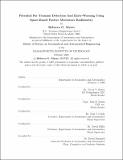| dc.contributor.advisor | Paul J. Cefola and David Miller. | en_US |
| dc.contributor.author | Myers, Rebecca G. (Rebecca Gwen) | en_US |
| dc.contributor.other | Massachusetts Institute of Technology. Dept. of Aeronautics and Astronautics. | en_US |
| dc.date.accessioned | 2008-11-07T14:09:43Z | |
| dc.date.available | 2008-11-07T14:09:43Z | |
| dc.date.copyright | 2008 | en_US |
| dc.date.issued | 2008 | en_US |
| dc.identifier.uri | http://hdl.handle.net/1721.1/42913 | |
| dc.description | Thesis (S.M.)--Massachusetts Institute of Technology, Dept. of Aeronautics and Astronautics, 2008. | en_US |
| dc.description | This electronic version was submitted by the student author. The certified thesis is available in the Institute Archives and Special Collections. | en_US |
| dc.description | Includes bibliographical references (p. 141-150). | en_US |
| dc.description.abstract | The threat of a tsunami in coastal communities is considerable, especially in the Pacific and Indian Oceans. Current warning systems consist of two networks: (1) a network of seismometers, and (2) a network of sea level gauges and bottom pressure recorders. Bottom pressure recorders communicate with ocean surface buoys, which send the data to processing centers through satellite communication uplinks. The ability to quickly and accurately detect a tsunami in the deep ocean is proposed using a new space-based passive microwave radiometer system. Passive microwave radiometry can detect oceanic parameters such as sea-surface temperature and sea surface roughness to contribute to earlier tsunami detection, when the tsunami is farther from shore, which will increase the reaction time for at-risk coastal communities. This thesis will outline a physics based approach to manipulating brightness temperature data from the ocean's surface through the variation as a result of the satellite platform, the sensor, its location, the antenna, and other considerations. The thesis will give a description of how each component of the overall system will change the surface data because the observations are space-based. The thesis will also outline how the current detection system can be compared to the new space-based system. In the future, the comparison method can be used to make an argument to support the system with the best capability to serve as an efficient and accurate tsunami early-warning system. | en_US |
| dc.description.statementofresponsibility | by Rebecca G. Myers. | en_US |
| dc.format.extent | 150 p. | en_US |
| dc.language.iso | eng | en_US |
| dc.publisher | Massachusetts Institute of Technology | en_US |
| dc.rights | M.I.T. theses are protected by
copyright. They may be viewed from this source for any purpose, but
reproduction or distribution in any format is prohibited without written
permission. See provided URL for inquiries about permission. | en_US |
| dc.rights.uri | http://dspace.mit.edu/handle/1721.1/7582 | en_US |
| dc.subject | Aeronautics and Astronautics. | en_US |
| dc.title | Potential for tsunami detection and early-warning using space-based passive microwave radiometry | en_US |
| dc.type | Thesis | en_US |
| dc.description.degree | S.M. | en_US |
| dc.contributor.department | Massachusetts Institute of Technology. Department of Aeronautics and Astronautics | |
| dc.identifier.oclc | 244303119 | en_US |
